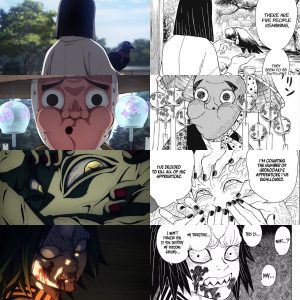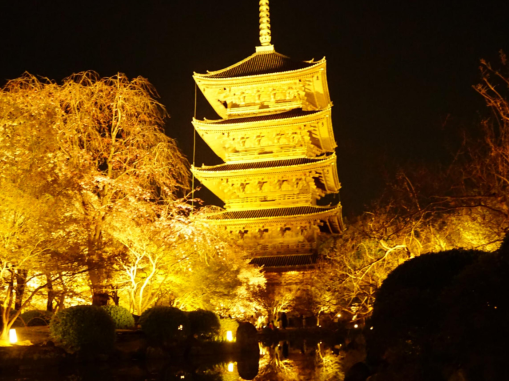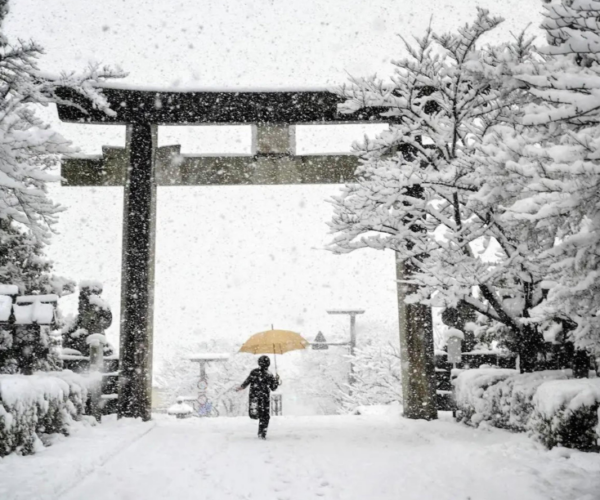This article originally featured in the December 2020 issue of Connect.
Janine de Villa (Wakayama)
I can’t speak for other Assistant Language Teachers, but one of my favorite seasons to go all out in a lesson is Halloween. Every year, I try to figure out what’s popular among my students and base my Halloween costume on that. This year was a no-brainer. I decided to go as Kochō Shinobu, a character from the hit show Kimetsu no Yaiba (Demon Slayer) and, needless to say, the kids (and even the adults!) went crazy for it.
In this article, armed with my humble observations, knowledge of the first season, and my love for all things shōnen, I want to tackle what makes Kimetsu no Yaiba so special.
But first, let me clear some things up: Shōnen (少年) is a Japanese word used to describe young boys under 15 years of age. As a manga term, it encompasses a whole genre of anime and manga targeted towards that demo-graphic. The majority of works in this genre are action-based adventures, typically undertaken by a male protagonist and his cohort, in a fictional setting. Though some titles, especially sports-centric ones, ground themselves more on reality, a common feature in every shōnen work is climactic battle sequences.
Kimetsu no Yaiba fits this description well. Serialized in the popular Shōnen Jump, a weekly manga anthology magazine, Kimetsu no Yaiba tells the story of Kamado Tanjirō, the eldest son of a coal-mining family. Tanjirō’s world is teeming with demons, who eventually attack his family while he is away for work. Tanjirō goes home to find his little sister, Nezuko, the only one with her life spared, but at the cost of having been turned into a demon. From here, Tanjirō joins the Demon Slayer Corps in the hopes of finding a way to bring his sister back to normal.
So, how did Kimetsu no Yaiba become so popular?
The Unique Sibling Dynamic
One of the reasons I gravitated towards the shōnen genre at such a young age was
how straight-to-the-point its premise is. Dragonball is about a boy set out to collect magical wish-granting dragon balls, One Piece is about a boy in a journey to discover the ultimate treasure called One Piece; and Kimetsu no Yaiba is about a young boy who
slays demons. What makes Kimetsu no Yaiba stand out among the rest, however, is the relationship between Tanjirō, and his little sister, Nezuko.
The classic shōnen protagonist is viewed as the courageous underdog by society. He is usually accompanied by a group of equally formidable friends that he would take a bullet for. However, whenever the show calls for a major battle scene, the main character faces the enemy
alone. Tanjirō, however, is always accompanied by Nezuko, hidden in the box he carries on his back. Only when the going gets tough for Tanjirō does she spring out, using her demon powers to aid her brother against other demons. She literally has his back.
Tanjirō and Nezuko, Ace and Luffy, Sasuke and Itachi, Edward and Alphonse: siblings in main-stream shōnen titles are quite abundant. However, the emphasis tends to be on the bond between brothers. Tanjirō and Nezuko’s relationship is akin to that of Romeo and Juliet, in that they are two people from two very different worlds who care about each other deeply. However, instead of star-crossed lovers, they are brother and sister. The risk of them being together is further explained in the show, but their dynamic just pulls on your heartstrings and you can’t help but cheer them on from the sidelines. Whereas most protagonists’ call to adventure revolves around a more self-centred goal, Tanjirō’s is simply to protect his sister, his only remaining family, at all costs.

An Open Love Letter to the Japanese Inaka
Most foreigners’ basic knowledge of Japan can be attributed to three major eras: Edo, Meiji and Shōwa. A lot of shōnen manga draw inspiration from Edo period Japan (1603-1868). Economic growth paired with strict isolationist foreign policies made for a period of relative peace and a vibrant cultural scene. Manga artists look to the Edo period when they want their work to showcase that signature “age of samurai” flair (e.g. Gintama, Samurai Champloo). The Meiji era (1868-1912) brought with it a lot of political and social change in Japan, which in turn also provided plenty of material for manga artists to work with (e.g. Rurouni Kenshin). Finally, the Shōwa era (1926-1989) gave birth to pop idol culture and, although there are not many anime set in this era, one cannot deny the insane popularity of more recent anime focusing on idol groups (e.g. Love Live!, Uta no Prince-Sama, etc.).
Which brings us to Kimetsu no Yaiba, which is set in Taishō era Japan. The Taishō era is a lesser-known period in Japanese history, sandwiched between the Meiji and Shōwa era, and spanning only 12 years! Despite this, I find the juxtaposition of old feudal villages and a slowly Westernizing urban backdrop to be a smart means of story progression. The story starts off in the remote mountains, heading down to small agricultural towns and finally to the city capital with a myriad of residents, both in traditional kimono and Western suits, alighting steam-powered passenger trains. The settings not only provide an endless roster of fun backdrops to gawk at, but also give Tanjirō and the gang a chance to be more relatable to those living outside Japan’s major cities.
As an ALT in the countryside, I can see glimpses of the Kumano Kodo, an ancient pilgrimage network in my placement prefecture, in the mountains where Tanjirō lives and eventually does his training. Though Kimetsu no Yaiba creator, Gotōge Koyoharu, didn’t specify where the story is set, many believe that he drew inspiration from his home prefecture of Fukuoka. Coincidentally, there is a place called Kamado Shrine in rural Fukuoka that was established to protect the Dazaifu government from a “demon gate.” If I could find familiarity in the show, I could only imagine how my students, who have lived in the inaka (countryside) for their whole lives, feel. The scenes where Tanjirō and friends find themselves in Tōkyō, dazzled by the bright lights of the big city must especially strike a chord.
Marketable Characters
Each character in Kimetsu no Yaiba has a distinct look, from the patterns on their haori (jackets worn over kimono) to the color palettes of their hair, which makes for a cornucopia of merchandising options. Promotion for anything Kimetsu no Yaiba parallels even that of any One Piece promotion I’ve seen. Unlike One Piece though, Kimetsu no Yaiba is a fairly short series, with only 26 anime episodes and one movie so far. However, that doesn’t stop them from making sure that Kimetsu no Yaiba is seen literally everywhere you go. I bet you’ve seen at least one kid repping their favourite character’s haori pattern with a homemade Kimetsu no Yaiba face mask.
 Production Quality Over Quantity
Production Quality Over Quantity
It’s a well-known fact that successful shōnen titles try to churn out as much weekly content as possible. Take, for example, One Piece. With over 900 episodes and counting over the span of two decades, it is not feasible for animators to prioritize clean animation with a weekly deadline. As such, dedicated fans don’t necessarily watch the show expecting a visual masterpiece. However, there was a shift in the early 2010s from the typical long-running series format of anime to more seasonal works which, in turn, gave animators more leeway to work on aesthetics.
A series with a solid story and charismatic characters is one thing, but add crisp, fluid animation into the mix, and you’ve got yourself a hit. I have to give major props to Ufotable, the studio that produces Kimetsu no Yaiba, for bringing this show to life so beautifully. The last time I was this impressed with an anime adaption was back in 2013 with Shingeki no Kyojin (Attack on Titan). Coincidentally, similar to Shingeki no Kyojin, the art in the anime adaptation of Kimetsu no Yaiba had a wider appeal compared to the manga.
As with any shōnen battle series, the climactic fights make or break the continued interest of fans. Each demon was written with a backstory, to garner sympathy and a unique power, keeping each encounter fresh, but it wouldn’t be as effective if it weren’t for how much care was put into making it look aesthetically pleasing as well.
Kimetsu in the Current Times
If I told my 9-year-old self how readily available manga and anime would be online in 2020, she wouldn’t have believed me. Streaming sites like Netflix and Amazon Prime make for easy watching (and rewatching) of Kimetsu no Yaiba. The fact that they are also legal methods is a big deal in Japan, with its strict copyright laws. Despite these easy online access methods, physical manga sales of Kimetsu no Yaiba are also on fire, breaking One Piece’s 2011 record for most copies sold within a year.
As someone who only just watched the anime last summer, I admit I was late to the party. With Kimetsu no Yaiba’s weekly manga serialization ending last May, I wasn’t sure if the Kimetsu hype would last until Halloween, thus rendering my costume irrelevant. However, following the release of the movie sequel, Demon Slayer: Infinity Train, on October 16, which promptly smashed the box office record previously held by none other than Studio Ghibli’s 2001 mega-hit Spirited Away, the series’ popularity has reached an all-time high.
Janine is the very first Philippine JET in Wakayama and no one will ever hear the end of it. She is an ordinary person with an extraordinary talent for binging shows, making to-do lists and doing her best.
Photos by Janine de Villa.
Media by Ufotable and Koyoharu Gotōge.
Graphics from Freepik




